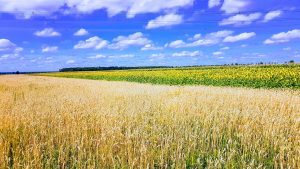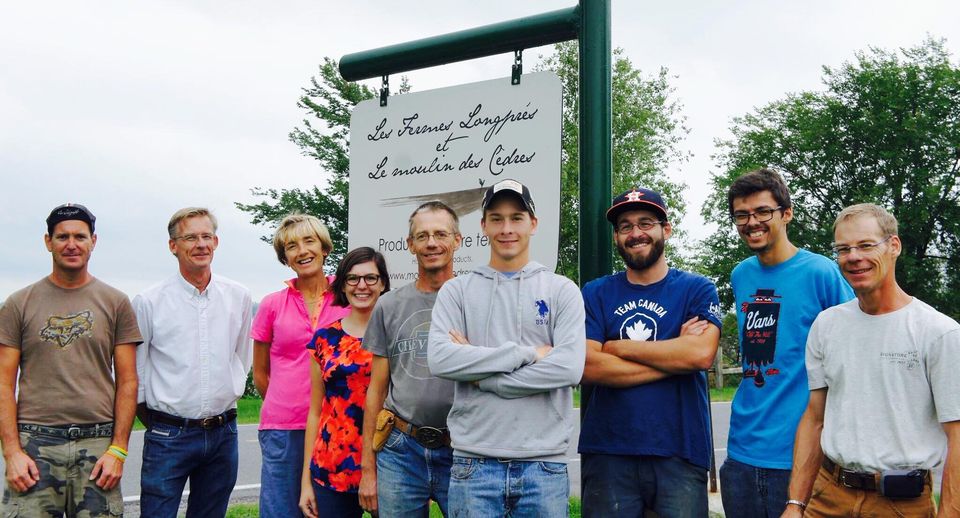By Rob Wallbridge
Many organic farms can point to increased biodiversity and enhanced soil health as the result of their management practices. At Les Ferme Longprés in Quebec, the Dewavrin family has made conserving soil their central principle, and they have continually adapted their management with this goal in mind. The difference may seem subtle, but when applied across more than 1,600 acres of field crops, the results exemplify regenerative agriculture: minimal tillage, extensive cover crops, reduced inputs, and high-yielding, high quality crops.
Ridge-till leads the way

A field of spring wheat and sunflowers grown at Les Ferme Longprés
Les Fermes Longprés began in 1977, when Luc and Simone Dewavrin emigrated from France to the shores of the St. Lawrence River just upstream from Montreal, Quebec to give their three sons a chance to farm. After getting diplomas in rural engineering, industrial engineering, and agricultural technology (skills that would serve them well in building and adapting machinery for organic farming), Thomas, Loïc, and Côme took over the operation in 1993.
The year before, the farm adopted the relatively new ridge-till technique—growing corn and soybeans on raised ridges built the previous year. The brothers noticed immediate improvements in their heavy clay soils: the soil on the ridges dried out and warmed up earlier, winter erosion was reduced, and soil structure improved. Over a quarter of a century later, an integrated system of ridge-till and cover cropping continues to play an integral role in crop production on the farm.
Minimizing tillage, maximizing biology
In the current crop rotation, wheat is seeded following soybeans: winter wheat is broadcast into standing soybeans before leaf drop or spring wheat is planted the following spring. Next, clover is broadcast during the last pass of a tine weeder for weed control. After wheat harvest, the clover over-winters and grows until July of the following year, when it is incorporated with a cultivator designed to only work 3-4 inches deep while completely incorporating the clover. During the same pass, forage peas are seeded. Before the peas germinate, the field is ridged in preparation for corn. The Dewavrins have discovered that the combination of a year-long clover crop, coupled with winter-killed forage peas, supplies enough nitrogen, released at the right time, to produce average corn yields of 160bu/ac with no additional fertility. The deep-rooted clover also maintains and improves soil structure.
Corn is seeded directly into the ridges built the previous year. Later, a row-crop cultivator with wide sweeps eliminates weeds between the rows, and a final pass with ridging wings effectively buries weeds in the crop. During this last pass, annual ryegrass is broadcast. In 2020, the Dewavrins began experimenting with biannual chicory as an inter-seeded cover crop in their corn.
The spring following corn harvest, the customized ridge-till planter removes the top of the ridge to seed soybeans into the freshly-exposed soil, pushing the corn residue and a bit of soil into the valleys to bury any ryegrass that managed to survive the winter. The first of two or three passes with the camera-guided cultivator uses cutaway discs to remove weeds within three-quarters of an inch of the tiny soybeans while finishing the job of burying corn residue and cover crop.
Of course, no crop rotation can always follow the ideal: in dry years, clover may fail to establish in the wheat, so the Dewavrins will no-till forage peas directly into the wheat stubble. In a rotation that eliminates primary tillage, perennial weeds like Canada thistle tend to be the biggest challenge, and the family is not afraid to sacrifice some crop to repeatedly mow thistle patches, exhausting root reserves and even introducing disease into the weakened plants.
After building and balancing their soils with amendments like manure and lime, the Dewavrins find that the soil system appears to be maintaining fertility with minimal inputs. An application of 1.1 to 1.3 tons per acre of chicken manure in the fall before the wheat crop is the only soil amendment applied in the four-year rotation. Regular soil tests show that nutrient levels are stable year over year with consistent yields. There’s little doubt that minimizing tillage disturbance while maintaining living roots throughout most of the year has optimized the nutrient cycling ability of the soil.
Resiliency through diversity
Most of the acreage is divided into strips 60 feet (18m) wide. These strips increase the beneficial “edge effect” for their crops and encourage biodiversity that controls pests and disease. Research in conjunction with the University of Montreal, for example, has shown beetles moving out of the wheat strips at harvest to feed on aphids in the neighboring soybean crops. The farm monitors for Western bean cutworm populations every year but has never experienced major problems. Bat houses and 7.5 miles (12km) of shelterbelts on the farm also contribute to an integrated pest management strategy that has eliminated the need for any pesticides. The shelterbelts also reduce wind erosion across the mostly flat landscape.
Adding value
Although Les Fermes Longprés have led the pack in adopting innovations like new crops, ridge-tillage, and precision farming technology, when genetically engineered crops were introduced in the mid-1990s, they took the opposite path and pursued organic certification, farmer-led seed breeding, and on-farm value-adding.
In 1995, they began direct-marketing cold-pressed oil from sunflowers grown on the farm. 2016 saw the culmination of a three-year effort to produce high-quality white flour from wheat grown on the farm. After initially marketing under their “Le Moulin des Cedres” brand, the farm teamed up with a Quebec-based organic farmers cooperative to sell under the “Co-op AgroBio” brand. By 2019, the flour business had grown to the point where the sunflower oil business and crop acreage was turned over to another member of the Co-op.
True sustainability
2019 marked another turning point: after five years of planning and preparation, Loïc, Thomas, and Côme retired and turned the farm over to the next generation. Today, Loïc’s sons Gregory and Matthew manage the farm while Thomas’ daughter Justine oversees the milling operation. This may be the ultimate testament to sustainable, regenerative agriculture: a farm able to capture the energy and support the passion of three generations.
Rob Wallbridge is an organic farmer and agronomy sales lead at SureSource Agronomy.









